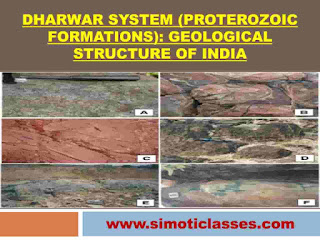Dharwar System (Proterozoic Formations)
The geologic time extends from 2500 million years ago to 1800 million years ago. These are the first metamorphosed sedimentary rock systems known as the Dharwar System in the Indian Geological Time Scale, as they were studied for the first time in the Dharwar district of Karnataka.
They are composed largely of igneous debris, schists, and gneisses.
The Dharwar rocks occur in scattered patches in;
- Dharwar and Bellary districts of Karnataka and extends up to Nilgiris and Madurai districts of Tamil Nadu.
- The Aravallis, Rialo (Delhi series) from Delhi to the South of Alwar and the Himalayan region.
The Dharwar rocks are rich in minerals like iron ore, manganese, lead, zinc, gold, silver, dolomite, mica, copper, tungsten, nickel, precious stones, and building materials.
|
Name of the series of Dharwar System |
Distribution in India |
Significant Features |
Champion Series |
1. NE of Mysore city to the east of Bangalore. 2. It stretches in the Kolar and Raichur districts of Karnataka. |
2. Depth= >3.5 Km. 3. Gold content= 5.5 per tonne of the ore. 4. Headquarters of the National Institute of Miner's Health is located here. |
|
Champaner Series |
1. Lies in the outlier of the Aravalli system in the vicinity of Vadodara. |
1. Minerals: Quartzites, conglomerates, phyllites, slates, limestones, and marbles. 2. Popular for the green variety of marble. |
Chilpi Series |
1. Occupies parts of Balaghat, Jabalpur, and Chindwara districts of Madhya Pradesh. |
1. Minerals: grit, phyllite, quartzites, green stones, magniferous rocks. |
Closepet Series |
1. Distributed in Balaghat and Chhindwara districts of Madhya Pradesh. |
2. Minerals found: quartzite, copper pyrite, magniferous rocks. 3. Ore supplied to the Malanjhand Copper plant. |
|
Iron Ore Series | 1. Distributed in Singhbhum, Bonai, Mayubhanj, Keonjhar in the form of a range. | 1. It is about 65 km in length has reserves of about 3000 million tonnes of iron ore. 2. Iron ore is supplied to Jamshedpur, Durgapur, Rourkela, and Bokaro Steel plants. |
| Khondolite Series | ||
|
Rialo Series (Delhi Series) |
1. Extends from Delhi (Majnu ka Tila) to Alwar (Rajsthan in the northeast to southwest direction). |
|
2. Rich in mica, dolomite, schist, and marble (Superiormost quality). |
||
1. Series spreads over Nagpur and Bhandara districts of Maharashtra and Chhindwara district of Madhya Pradesh. |
Previous Page:Urbanization (Section- H): JPSC
Next Page:Western Ghats: A World Heritage Site: Geography- JPSC/ JSSC



















0 comments:
Post a Comment